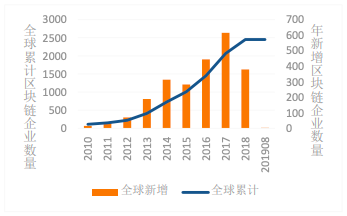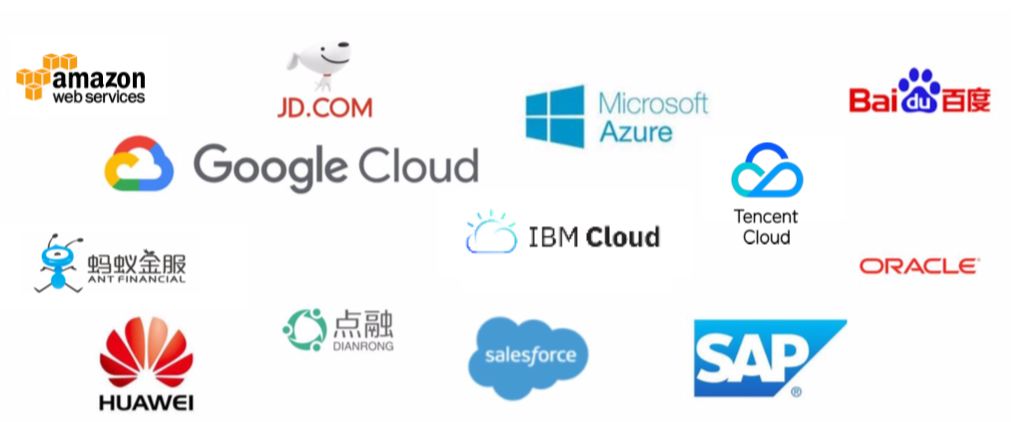Blockchain competition: What are the differences between China and the United States?
Blockchain technology originated in Bitcoin in 2008, but it was only six years later that people realized that the application of this technology was not just cryptocurrencies.
In 2014, "Blockchain 2.0" became a term for a decentralized blockchain database. In 2015, domestic companies such as Baidu, Tencent, and Alibaba have started to form teams to study blockchain. Foreign R3 groups have become blockchain alliances, and the Linux Foundation has launched the Hyperledger hyperledger project. This year, large-scale Internet companies at home and abroad have low-key layout of blockchain.
From 2014 to 2020, another six years have passed. During this period, the number of global blockchain technology companies has almost tripled. According to the ICT Blockchain White Paper, as of August 2019, there are a total of 2,450 blockchain companies worldwide, of which 23% are focused on technology research and development. Among them, the number of blockchain companies in China and the United States accounts for more than half of the total number of global blockchain companies.

- Wall Street predators lose coins, crypto world "lost shares"
- Deconstructing the DeFi ecosystem, and multiple ways for the oracle to optimize the DeFi ecosystem
- DigixDAO dissolution proposal has been passed, will tens of thousands of Ethereum flow into the market?
Global Blockchain Enterprise Growth Trend, Source: China Academy of Information and Communication Technology
At the end of 2019, China raised the blockchain to a strategic position in technology, accelerating the practical application of blockchain technology. 2020 is called "the first year of the blockchain landing". On the landing of the blockchain, we interviewed Brian Behlendorf, the executive director of the super ledger.
Brian was previously the main developer of the Apache Web server, a well-known open source software organization, and began developing the hyperledger in 2016. According to Brian, he first contacted the blockchain through venture capital, and later came into contact with projects such as Ethereum. One of the important reasons that attracted him to Hyperledger was the possibility and uncertainty brought by the blockchain. Of course, large companies like JP Morgan, IBM, etc. are participating, which is also attractive in itself.
In the four years since the release of the super ledger, there have been more than 275 members worldwide, including more than 50 members in China, including Ant Financial, Baidu, Xiaomi, Huawei, etc. Hyperledger does not make tokens, but only focuses on blockchain technology. Its platform Hyperledger Fabric now supports all mainstream cloud services.

Main cloud services supported by Hyperledger Fabric, Source: Hyperledger
Blockchain: From concept experiment to implementation
Brian pointed out that in the last two years, the application of blockchain has come to the actual industry from the concept experiment. Among them, the traceability of supply chain, trade finance and KYC (domestic term is digital ID DID) are three of the most concerned and developed field.
Tantalum is a metal used in the production of capacitors for electronic products, and Rwanda is its largest producer, with about half of the world's supply in 2014. However, the mineral market is becoming more vigilant about the source of tantalum metal. Many mines may have problems such as mining of children or slaves and incorrect mining records. The most important thing is that tantalum has been written to combat illegal trade as one of the common conflict minerals. International agreement. At this time, it is necessary to trace the source of tantalum metal in Rwanda.
In 2018, the Rwandan government partnered with London-based startup Circulor to adopt a supply chain tracking solution based on Hyperledger Fabric, adding facial recognition and QR code technology to achieve full process coverage from mining to production. Supply chain traceability not only solves our common daily problems such as food, but also has a greater impact on people in areas of international conflict.

Mining tracking process, source: Hyperledger
The financial industry is an area where everyone is talking about blockchain. Let's talk about the landing situation in terms of letter of credit settlement.
Letter of credit settlement is a settlement method for commodity transactions and labor supply between various business units. The bank serves as an intermediary and provides a letter of credit as a guarantee of payment. It is highly secure and is often used in international trade. However, the procedures of this settlement method are more complicated, and must fulfill a series of procedures such as issuance, notification, examination, presentation, examination, examination, advance, repayment, and redemption. For importers, higher fees need to be paid, and a certain deposit is required. The cost is much higher than remittances and collections.
China Minsheng Bank and CITIC Bank have jointly developed a domestic letter of credit transmission platform based on blockchain, which does not need to rely on the SWIFT system to provide information exchange support. It is independent and controlled by China, which shortens the delivery time.

Letter of credit settlement framework after the introduction of blockchain technology, source: Hyperledger
At present, 14 banking units including China Merchants Bank, Industrial and Commercial Bank of China, China Construction Bank, China Minsheng Bank, Agricultural Bank of China, and Bank of Communications have introduced blockchain-based trade financing platforms in the China Banking Association.
Landing differences between China and the US: US KYC, Chinese justice
Will the regional differences between China and the United States lead to different landings of the blockchain? In fact, Brian believes that this difference is small but has its own characteristics.
China and the United States attach great importance to the two areas of traceability and finance when the blockchain is launched. In terms of traceability, the United States attaches great importance to food safety, and accordingly attaches great importance to food traceability. In contrast, domestic, more e-commerce platforms like Ali and JD.com track and trace the goods. For the financial industry, the United States is more exploring in the area of inter-bank business settlement. At home, like the letter of credit settlement, more exploration is made on the marginal business of the financial industry.
However, one application that the United States attaches great importance to but does not talk about in the country is KYC, which is often referred to as digital identity. This is particularly important in cross-border transactions. The two parties who have never met can learn more about each other based on this technology, such as nationality, credit and so on. This data was previously held by different financial institutions, and now it is possible to share some data that does not involve personal privacy but is much needed.
Especially in North America, KYC has been widely used. The local government of Canada has cooperated with some Internet companies and banks to build a KYC system for sharing personal or corporate information between governments, which has improved work efficiency. At the same time, KYC also has many practical applications in anti-money laundering.
"The use of blockchain in justice is unique to China and has not been seen much in the United States," Brian said.
With the development of digitalization in China, over 73% of civil cases in the country involve electronic evidence. Judicial evidence has entered the era of electronic evidence from the era of physical evidence. The unique characteristics of blockchain technology, such as immutability, non-repudiation, and multi-party participation, naturally fit the needs of electronic data storage.
At present, the Beijing Internet Court "Tianping Chain" has cross-linked 18 blockchain nodes, and has completed data docking of 25 application nodes in 9 categories, including copyright, copyright, and Internet finance. There are over 9 million data, and the amount of cross-chain certificate data has reached hundreds of millions. The Truth Technology LegalXchain judicial alliance chain covers the Internet courts in Beijing, Hangzhou, and Guangzhou. The alliance nodes have covered more than 17 authoritative judicial units such as IP360, notary agencies, judicial appraisal agencies, and courts. Actually, it has over 60 million legally sensitive documents And unstructured information.
Brian said that the development of mobile communications in the United States has actually been slower than that in China. This is because the United States originally had more network cables, so it had fewer 3G and 4G layouts. However, China did not have a layout in this area before, but developed faster in mobile communications. This logic is also applicable to the development of China's blockchain. The U.S. credit system is better than China, and the demand for blockchain seems less urgent, which makes China promote the blockchain faster in various industries than the United States.
Blockchain goes to the masses "unthinkable"
-
The security of the alliance chain is better. Members participating in the alliance are familiar with each other and have reached a certain consensus on some rules. If you encounter some problems, it is easier to solve. For example, a hacker attack, no one will manage it on the public chain, but someone in the alliance chain will be responsible for it. - The alliance chain is more conducive to processing sensitive data. The data of the company's contracts and transactions are actually unwilling to be seen. These data will be seen by everyone on the public chain, and it is easier to process these private data on the alliance chain.
It is undeniable that the ideal of "everyone is a node" on the public chain is full, but it is too difficult to be realistic in terms of technology or business model. "In 2020, the alliance chain will be more widely used and the products will be better used." Brian said.
-
Some existing applications will expand to a larger range. -
Some applications may be pilot at first, but may become mandatory afterwards. For example, Wal-Mart's application in food safety. - More application products will appear on the alliance chain.
Regarding the technical planning of the hyperledger, Brian said that it mainly depends on the community developers. However, Brian said that this year's super ledger will make efforts in terms of technical interoperability, such as opening up blockchain platforms between different companies such as Huawei, Ali, and IBM.
"Just like 20 years ago, it was impossible to imagine the mobile payment that is so popular now, the scenario of blockchain going to the masses is also difficult to imagine." Brian said, "I do n’t know or even care if blockchain is used, but It's integrated at the bottom of every application. "
We will continue to update Blocking; if you have any questions or suggestions, please contact us!
Was this article helpful?
93 out of 132 found this helpful
Related articles
- Which lending platform is better? We analyzed 8 DeFi platforms for you
- Story of Satoshi Nakamoto and crypto punks: these emails may be key to his identity
- Will the Bitcoin Liquid sidechain be more important than the Lightning Network in 2020?
- The road to DeFi on Bitcoin
- Opinion | Beyond BTC halving in 2020, these three major events will happen in the mining industry
- In 2020, the blockchain will scale from trials to large-scale applications in insurance, trade, notarization and other industry scenarios.
- Global FinTech Financing Report 2019: Blockchain Financing Amount Leads Above 261.9 Billion





